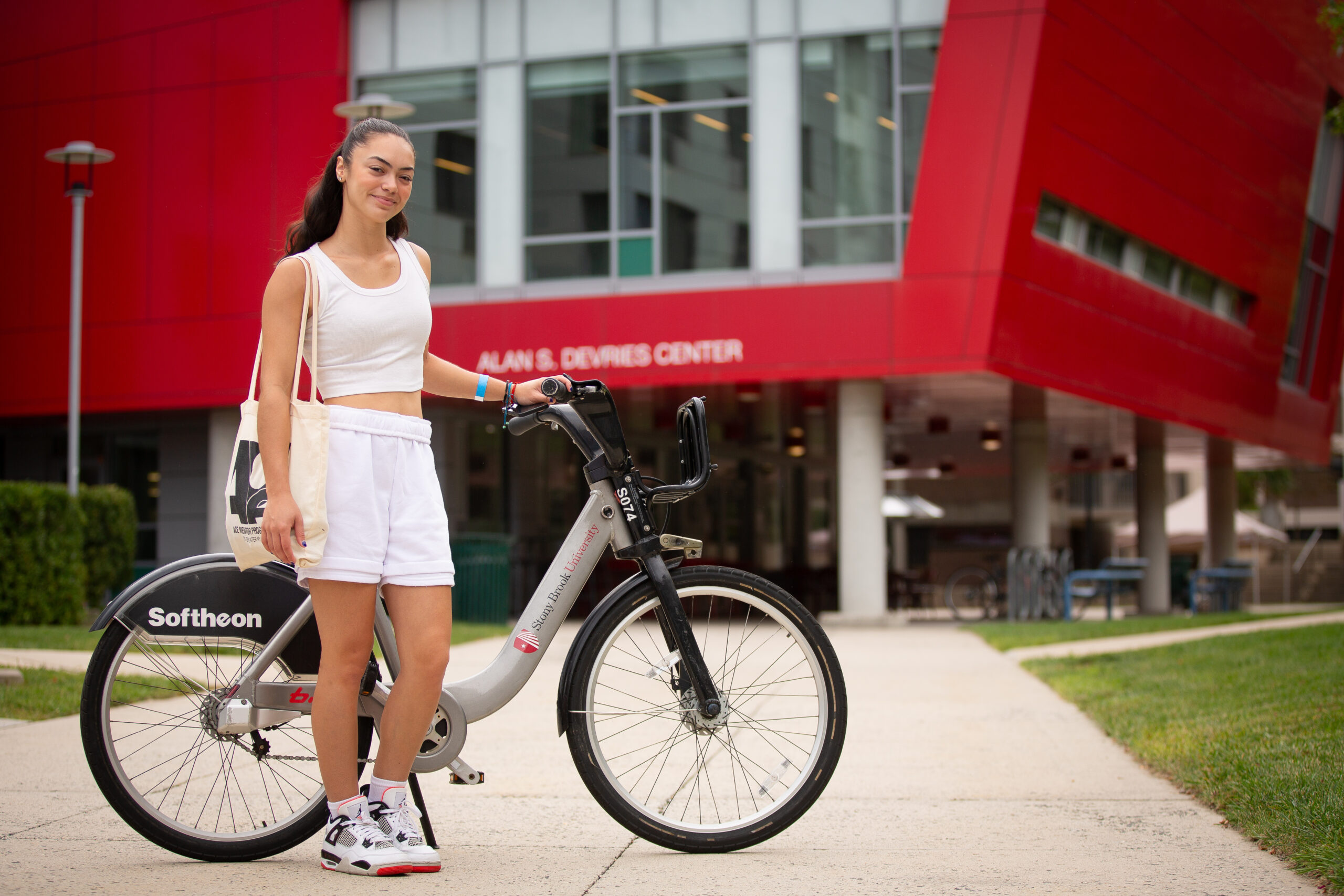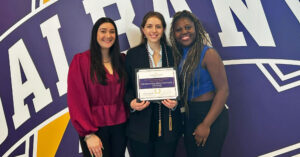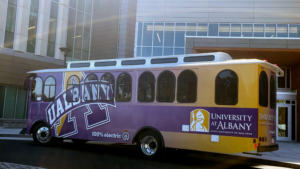At SUNY, we’re fighting for a cleaner, greener, and more sustainable world. From accredited, top-ranking programs to groundbreaking initiatives, SUNY prepares students across New York State and beyond to discover climate solutions, change environmental behaviors, and contribute to a greener economy.
Here are some incredible initiatives happening at SUNY right now:
Bike-friendly Campuses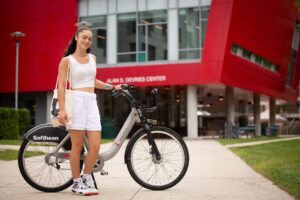
On SUNY campuses, biking has grown in popularity among students as a practical, healthy, and environmentally friendly substitute for more conventional forms of transportation.
The League of American Bicyclists has recognized and awarded nine SUNY campuses as Bicycle Friendly Universities for their efforts to make biking safe and convenient for students, faculty, and staff. Designated bike lanes, bike racks, repair stations, and safety rules, have been put in place on these campuses to promote biking. Campuses include:
- University at Albany
- SUNY Brockport
- University at Buffalo
- SUNY Cortland
- SUNY College of Environmental Science & Forestry
- Farmingdale State College
- Monroe Community College
- SUNY New Paltz
- Stony Brook University
Additionally, 14 institutions have implemented bike-share programs, which are simple to use and enable staff and students to get where they’re going quickly. These initiatives support sustainability while also lowering carbon emissions and improving air quality and health.
“Biking is the quickest and easiest way to get around campus. I enjoy it a lot and UAlbany provides a good infrastructure,” said a University at Albany student.
In addition to being good for health and well-being, encouraging students to use bikes as their main mode of transportation is an investment in the future. The transportation sector contributes significantly to New York’s carbon emissions, accounting for 26% of the state’s primary energy consumption. Transitioning to more environmentally friendly forms of transportation, like biking, can contribute to the decline of the state’s overall carbon footprint.
In short: Biking provides an easy commute on campus, improves health, and helps the planet.
Geothermal Energy
Earth’s interior heat is known as geothermal energy. It is produced once rocks undergo the slow breakdown of radioactive particles in the earth’s core, making it possible to recover hot water from subterranean reservoirs by drilling wells. This water can then be brought to the surface and used for various purposes, including heating, cooling, and electricity production. Currently, 14 SUNY campuses employ geothermal energy.
As an example, SUNY Oneonta’s Alunni Hall represents “(the) University’s growth and commitment to providing a world-class education to all our students”. The newly renovated Alumni Hall is setting a statement in reducing the campuses carbon footprint by installing geothermal wells as its main source of energy for heating and cooling. Between the renovation of Alumni Hall and two other energy conservation projects implemented in 2023, involving replacements of equipment related to coolers, Oneonta is projected to save 1,564,000 kBTU annually.
SUNY Old Westbury is also a role model. The campus rehabilitated the Natural Science Building with roughly 200 geothermal wells. The building serves students and faculty with modernized classrooms, teaching laboratories, research laboratories, and faculty office.
SUNY Sullivan is one of the leaders in geothermal energy, with 85% of the campus’s heating and cooling produced by a 500-ton geothermal system. The $9.8 Million Energy Efficiency Project made it possible for the campus to save a huge amount of energy and costs, while providing excellent energy efficiency and academic environment for students and faculty.
Going geothermal increases sustainability by saving a significant amount of energy annually, with SUNY projected to have saved 4.4 trillion BTU of energy from 2015 to 2025.
Paper Reduction
The most sustainable, secure, efficient, and cost-effective page is the one never printed. The newly implemented SUNY Printing Policy can save SUNY campuses 350,000,000 sheets of paper and reduce costs by around $15 million.
To reach the goals of the policy, 22 two campuses have already implemented central printing with 15 more campuses expected to do so by the end of 2024. Since the year 2020, SUNY has reduced paper for printing by 71%.
Why centralize printing? Campuses can cut down on the number of printers, save equipment supplies and provide additional features compared to smaller printers. With the networking capability, printing can be better controlled and managed for a more efficient printing and monitoring process. If all campuses centralize printing, and connect all printers to the network, it is estimated SUNY will conserve 35 million gallons of water, reducing carbon dioxide emissions by nearly 5,000 tons, and saving 43,000 trees annually.
To manage centralized smart printing, SUNY campuses have partnered with Toshiba America Business Solutions, Pharons, and PathForward to help campuses implement the Print Program more effectively.
The SUNY Printing Policy is set to help campuses reduce avoidable printing, saving a huge amount of money and resources such as water, trees, and carbon emissions.
Zero Emission Vehicles (ZEVs)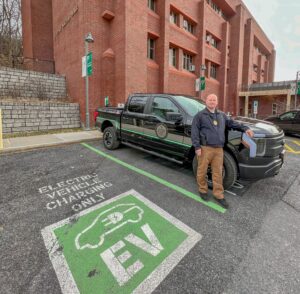
SUNY’s light duty fleet vehicles will be fully electric by 2035.
The transportation industry currently makes up 26% of the New York State’s overall greenhouse gas emissions. To combat this, Governor Hochul’s 2022 executive order called on state agencies to increase the number of zero emission vehicles (ZEVs).
Right now, 206 electric vehicles at SUNY replace internal fossil fuel cars and can charge at the 226 EV charging ports that are spread across campuses.
SUNY ESF is the first SUNY campus to have an EV truck in their University Police Department fleet. The electric Ford F150 Lightning Pro has helped to reduce fossil fuel emission on campus and is joining six hybrid vehicles and 14 fully electric vehicles on campus.
Additionally, the University at Albany introduced a new electric trolley to their campus. With a maximum highway speed of 65mph, a 105-mile range, and 30 seat capacity this new ZEV is helping to displace 25,000 gallons of diesel fuel over the next decade. This means that more than 500,000 pounds of CO2 emissions will be reduced, resulting in a cleaner environment.
With these new vehicles, SUNY campuses and the state of NY will be a greener place.
To learn more about SUNY’s sustainable future, visit www.suny.edu/sustainability.


